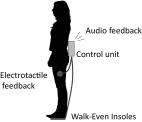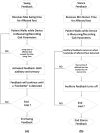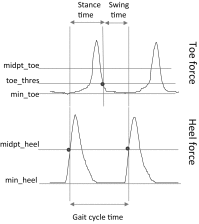Real-time biofeedback device for gait rehabilitation of post-stroke patients
- PMID: 30603178
- PMCID: PMC6208514
- DOI: 10.1007/s13534-017-0036-1
Real-time biofeedback device for gait rehabilitation of post-stroke patients
Abstract
In this work, we develop a device, called 'Walk-Even', that can provide real-time feedback to correct gait asymmetry commonly exhibited in post-stroke survivors and persons with certain neurological disorders. The device computes gait parameters, including gait time, swing time, and stance time of each leg, to detect gait asymmetry and provide corresponding real-time biofeedback by means of auditory and electrotactile stimulation to actively correct the user's gait. The system consists of customized force-sensor-embedded insoles adjustable to fit any shoe size, electrotactile and auditory feedback circuits, microcontroller, and wireless XBee transceivers. The device also offers data saving capability. To validate its accuracy and reliability, we compared the gait measurements from our device with a commercial gait and balance assessment device, Zeno Walkway. The results show good correlation and agreement in a validity study with six healthy subjects and reliability study with seventeen healthy subjects. In addition, preliminary testing on six post-stroke patients after an 8-week training shows that the Walk-Even device helps to improve gait symmetry, foot pressure and forefoot loading of the affected side. Thus, initial testing indicates that the device is accurate in measuring the gait parameters and effective in improving gait symmetry using real-time feedback. The device is portable and low cost and has the potential for use in a non-clinical setting for patients that can walk independently without assistance. A more extensive testing with stroke patients is still ongoing.
Keywords: Biofeedback; Gait asymmetry; Rehabilitation; Stroke.
Conflict of interest statement
The authors (I-Hung Khoo, Panadda Marayong, Vennila Krishnan, Michael Balagtas, Omar Rojas, Katherine Leyba) declare that they have no conflict of interests in relation to the work in this article.Approval was obtained from the CSULB Institutional Review Board for the experiment involving human subjects.
Figures


















Similar articles
-
A Portable Gait Asymmetry Rehabilitation System for Individuals with Stroke Using a Vibrotactile Feedback.Biomed Res Int. 2015;2015:375638. doi: 10.1155/2015/375638. Epub 2015 Jun 16. Biomed Res Int. 2015. PMID: 26161398 Free PMC article.
-
Gait Training in Chronic Stroke Using Walk-Even Feedback Device: A Pilot Study.Neurosci J. 2016;2016:6808319. doi: 10.1155/2016/6808319. Epub 2016 Nov 24. Neurosci J. 2016. PMID: 28003995 Free PMC article.
-
Development of the RT-GAIT, a Real-Time feedback device to improve Gait of individuals with stroke.Annu Int Conf IEEE Eng Med Biol Soc. 2015 Aug;2015:5724-7. doi: 10.1109/EMBC.2015.7319692. Annu Int Conf IEEE Eng Med Biol Soc. 2015. PMID: 26737592
-
Biofeedback for Post-stroke Gait Retraining: A Review of Current Evidence and Future Research Directions in the Context of Emerging Technologies.Front Neurol. 2021 Mar 30;12:637199. doi: 10.3389/fneur.2021.637199. eCollection 2021. Front Neurol. 2021. PMID: 33859607 Free PMC article. Review.
-
Balance retraining after stroke using force platform biofeedback.Phys Ther. 1997 May;77(5):553-8. doi: 10.1093/ptj/77.5.553. Phys Ther. 1997. PMID: 9149764 Review.
Cited by
-
Wearable Sensor-Based Real-Time Gait Detection: A Systematic Review.Sensors (Basel). 2021 Apr 13;21(8):2727. doi: 10.3390/s21082727. Sensors (Basel). 2021. PMID: 33924403 Free PMC article.
-
Systematic review on wearable lower-limb exoskeletons for gait training in neuromuscular impairments.J Neuroeng Rehabil. 2021 Feb 1;18(1):22. doi: 10.1186/s12984-021-00815-5. J Neuroeng Rehabil. 2021. PMID: 33526065 Free PMC article.
-
Robotic Biofeedback for Post-Stroke Gait Rehabilitation: A Scoping Review.Sensors (Basel). 2022 Sep 22;22(19):7197. doi: 10.3390/s22197197. Sensors (Basel). 2022. PMID: 36236303 Free PMC article.
-
Instant gait classification for hip osteoarthritis patients: a non-wearable sensor approach utilizing Pearson correlation, SMAPE, and GMM.Biomed Eng Lett. 2025 Jan 9;15(2):301-310. doi: 10.1007/s13534-024-00448-2. eCollection 2025 Mar. Biomed Eng Lett. 2025. PMID: 40026883 Free PMC article.
-
The Effects of Auditory Feedback Gait Training Using Smart Insole on Stroke Patients.Brain Sci. 2021 Oct 21;11(11):1377. doi: 10.3390/brainsci11111377. Brain Sci. 2021. PMID: 34827376 Free PMC article.
References
-
- Kim SY, Yang L, Park IJ, Kim EJ, Park MS, You SH, Kim YH, Ko HY, Shin YI. Correction to “Effects of Innovative WALKBOT Robotic-Assisted Locomotor Training on Balance and Gait Recovery in Hemiparetic Stroke: a Prospective, Randomized, Experimenter Blinded Case Control Study With a Four-Week Follow-Up”. IEEE Trans Neural Syst Rehabil Eng. 2015;23:1128. doi: 10.1109/TNSRE.2015.2497058. - DOI - PubMed
LinkOut - more resources
Full Text Sources
Medical
